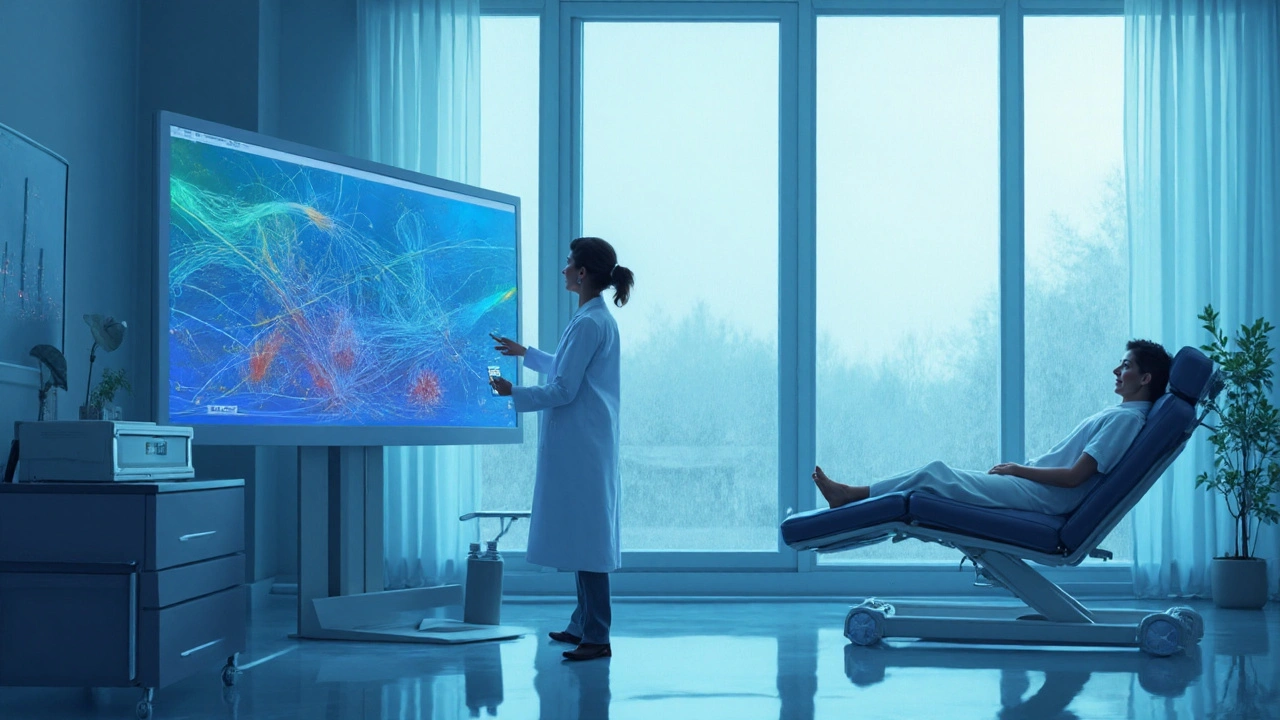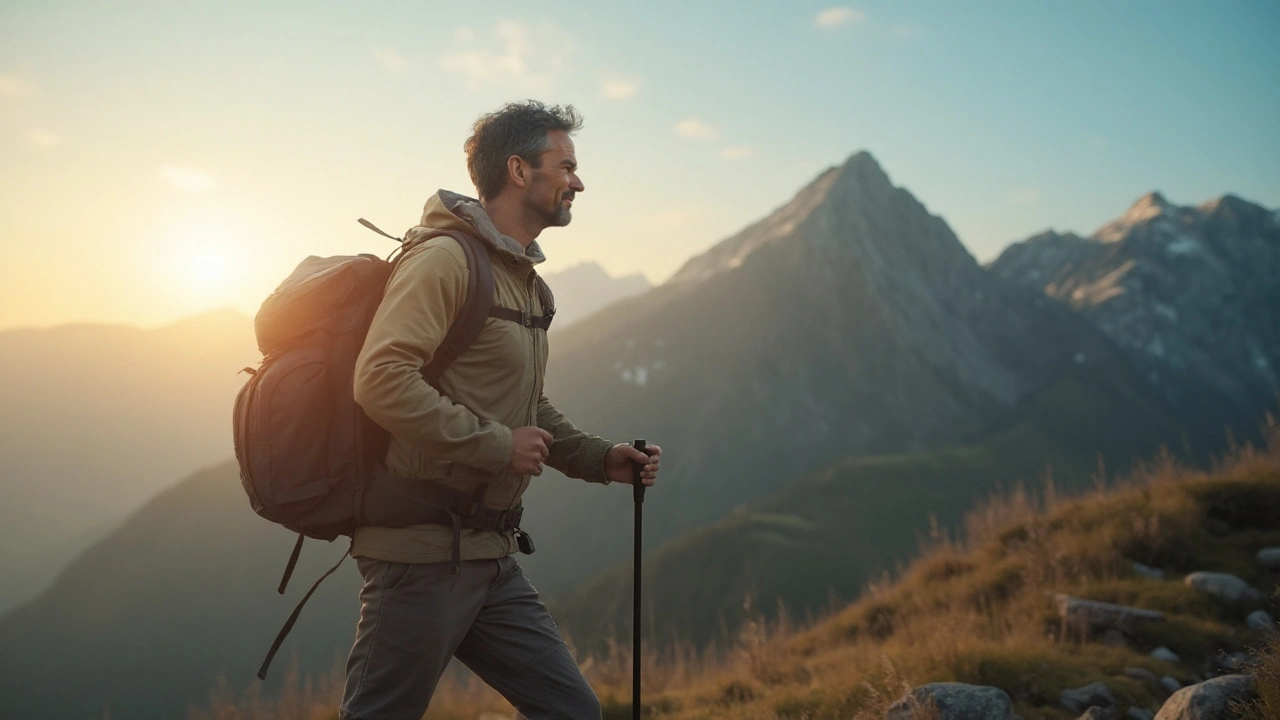Idiopathic Orthostatic Hypotension is a condition characterized by a sustained drop in systolic blood pressure of at least 20mmHg (or diastolic drop of 10mmHg) within three minutes of standing, without an identifiable secondary cause. People with this disorder often feel light‑headed, dizzy, or even faint when they move from lying down to sitting or standing. While genetics and hidden autonomic issues play a role, the environment around you can tip the balance from “okay” to “dangerous.”
What Exactly Is Idiopathic Orthostatic Hypotension?
To grasp why the weather matters, start with the basics. Orthostatic hypotension is a general term for any significant blood‑pressure drop upon standing. When the cause is unknown, clinicians label it idiopathic. Diagnosis usually involves a tilt‑table test that records heart rate and blood pressure while the patient is gradually tilted upright. The test reveals a blunted baroreflex response, meaning the body fails to quickly constrict blood vessels and raise pressure.
Key physiological players include the sympathetic nervous system, which should activate to tighten vessels, and the overall blood volume. When either is compromised, blood pools in the legs, and the brain receives less oxygen.
How Temperature Shapes Blood Pressure Drops
Heat is a silent aggressor. When ambient temperature rises, skin blood vessels dilate to release heat, a process called vasodilation. This sudden extra capacity in the peripheral circulation forces more blood away from the core, lowering central venous return. For someone with idiopathic orthostatic hypotension, the already‑weak baroreflex can’t compensate, leading to a sharper pressure plunge.
Research from the American Autonomic Society (2023) showed that a 5°C increase in room temperature produced an average additional 7mmHg drop in systolic pressure for IOH patients, compared to a 2mmHg drop in healthy controls. The effect intensifies when humidity is also high because sweat evaporates less, further increasing skin blood flow.
Humidity: The Sweat‑Retention Factor
High humidity throttles sweat evaporation, so the body retains more fluid on the skin surface. This paradoxically promotes even more vasodilation as the nervous system tries to keep skin temperature down. The result is a double hit: fluid loss through sweat plus reduced plasma volume, both of which worsen the orthostatic drop.
One field study in Phoenix (2022) measured IOH patients walking a 500‑meter indoor track under dry (30% RH) and humid (70% RH) conditions. Those in the humid environment experienced a 12% larger decrease in systolic pressure after standing for two minutes.
Altitude: Thin Air, Thin Pressure
Going up in altitude reduces oxygen availability, which triggers a cascade of sympathetic activation to maintain tissue oxygenation. While this might seem helpful, the body’s response also includes heightened respiration and decreased plasma volume due to increased diuresis. For IOH sufferers, the net effect is often a modest but clinically important additional drop in standing blood pressure.
A 2024 European multicenter trial found that IOH patients moving from sea level to 2,500m experienced an average 5mmHg extra systolic fall compared with their baseline at sea level.

Seasonal and Diurnal Variations
Temperature, humidity, and even daylight length shift with the seasons. Summer months bring high heat and humidity, while winter brings cold‑induced vasoconstriction that can actually *help* maintain pressure but may cause other issues like increased blood viscosity. Additionally, blood pressure follows a diurnal rhythm: it’s lowest in the early morning and rises toward evening. When a hot summer afternoon coincides with the morning dip, IOH patients are most vulnerable.
Practical Strategies to Mitigate Environmental Triggers
- Stay hydrated: Aim for at least 2.5L of fluid daily, adjusting upward on hot or humid days.
- Electrolyte balance: Add a pinch of salt or an electrolyte solution to replace sodium lost through sweat.
- Temperature control: Use fans or air‑conditioning to keep indoor environments below 22°C (72°F).
- Clothing: Wear compression stockings to reduce leg pooling, especially in warm settings.
- Avoid rapid postural changes: Sit for a minute after standing, then rise gradually.
- Altitude acclimatization: Increase exposure slowly (e.g., spend a night at 1,500m before ascending higher).
Comparison of Key Environmental Factors
| Factor | Typical Effect on SBP (mmHg) | Main Physiological Mechanism | Primary Mitigation |
|---|---|---|---|
| Ambient Temperature | -5 to -10 (per 5°C rise) | Vasodilation → reduced central venous return | Cooling, hydration, compression garments |
| Humidity | -3 to -7 (high vs. low RH) | Sweat retention → plasma volume loss | Dehumidify, replace electrolytes |
| Altitude | -4 to -6 (at 2,500m) | Sympathetic surge + diuresis → lower plasma volume | Gradual ascent, fluid loading |
Connected Concepts Worth Exploring
Understanding IOH in the context of the environment opens doors to related topics. For instance, medication-induced hypotension (especially from antihypertensives) can amplify the same temperature‑related drops.
Chronic cardiovascular disease also compromises vascular elasticity, making temperature swings more hazardous.
Other lifestyle factors-like sleep deprivation, which raises sympathetic tone, or exercise intensity, which temporarily depletes blood volume-interact with environmental stressors. Readers interested in a deeper dive should look for articles on “Medication Management for Orthostatic Hypotension” and “Exercise Strategies for Autonomic Disorders.”

Frequently Asked Questions
What exactly triggers an episode of idiopathic orthostatic hypotension?
An episode typically starts when standing causes blood to pool in the legs, and the body’s baroreflex fails to quickly narrow the vessels or increase heart rate. Heat, humidity, dehydration, certain meds, and sudden posture changes are common catalysts.
How does hot weather make my dizziness worse?
Hot air forces skin vessels to open (vasodilation) so the body can lose heat. This shifts blood away from the heart, lowering the amount that returns to the brain. If the sympathetic nervous system can’t compensate, the pressure drop feels like light‑headedness.
Can I travel to high‑altitude destinations safely?
Yes, but plan a gradual ascent. Spend a night at an intermediate elevation, stay well‑hydrated, and avoid alcohol. If you notice new or worsening symptoms, descend and seek medical advice.
Do compression stockings really help?
Compression stockings apply external pressure to the lower limbs, limiting blood pooling. Studies show a 30‑40% reduction in symptom severity for many IOH patients, especially during hot days.
What role does hydration play compared to electrolytes?
Pure water restores volume but doesn’t replace sodium lost through sweat. Low sodium can trigger the renin‑angiotensin system, which may actually help raise pressure, but only if the body isn’t already over‑compensating. A balanced electrolyte drink is usually the safest bet.


Heat really messes with your blood pressure when you have idiopathic orthostatic hypotension it makes the drop way bigger than normal stay cool and drink water
In a thermally stressed environment the vasodilatory response overwhelms the compromised baroreflex in idiopathic orthostatic hypotension resulting in a pronounced systolic decline. Management therefore emphasizes environmental control alongside fluid and salt optimization
Hey, that sounds like solid advice i always tell my patients to keep a fan on and sip on some electrolyte water it really helps them feel steadier
Stop ignoring the heat, it kills you 😡🔥
When the air swells with heat it mirrors the inner turbulence of a failing reflex – a reminder that our bodies are not isolated from the climate 🌡️🤔 embracing cooling strategies becomes a practice of humility and self‑care
One must acknowledge that the thermodynamic principles governing cutaneous vasodilation are not merely anecdotal but are grounded in rigorous physiologic scholarship, thereby rendering simplistic lifestyle recommendations insufficient for the discerning clinician
Indeed, integrating those scientific insights with practical steps such as gradual posture changes and adequate hydration can bridge the gap between theory and patient comfort
Picture the heart as a lone lighthouse battling a storm of sweat and heat - each drop of fluid a beacon of hope, each sip of electrolyte solution a lifeline 🌊💧
Stop ignoring the heat, it kills you 😡🔥
Statistics clearly show a correlation between ambient temperature spikes and orthostatic intolerance; ignoring this data is tantamount to willful negligence
Could the interplay between sympathetic activation at altitude and plasma volume reduction be quantified to predict individual risk thresholds?
In the annals of autonomic physiology the phenomenon of idiopathic orthostatic hypotension (IOH) under varying environmental conditions has been a subject of both clinical intrigue and methodological rigour; the literature, as it stands, provides a mosaic of findings that, while illuminating, also beckon further explication. Firstly, the thermoregulatory vasodilatory cascade precipitated by elevated ambient temperatures engenders a peripheral pooling of blood which, in the absence of a robust baroreflex, culminates in a precipitous decline in cerebral perfusion. Secondly, humidity serves as an adjunctive factor, its retardation of evaporative cooling augmenting cutaneous blood flow and thereby exacerbating plasma volume depletion through insidious sweat retention. Thirdly, hypobaric hypoxia encountered at modest altitudinal ascents imposes a sympathetic surge that paradoxically coexists with diuretic‑induced hypovolaemia, a duality that may be captured only through longitudinal monitoring. Moreover, circadian rhythms impose an additional layer of complexity; the nadir of arterial pressure in the early morn dovetails with peak thermal loads in certain latitudes, thus creating a temporal vortex of vulnerability. Empirically, the 2023 American Autonomic Society study delineated a mean incremental systolic decrement of approximately seven millimetres of mercury per five degrees Celsius, a statistic that, when juxtaposed with the modest two‑millimetre shift observed in normotensive controls, underscores the delicate balance that IOH patients must maintain. In parallel, the Phoenix field investigation of 2022 elucidated a twelve‑percent amplification in systolic attenuation under humid conditions, a figure that resonates with the pathophysiological principles aforementioned. It is also noteworthy that acclimatization protocols, wherein patients ascend incrementally to elevated terrains, have demonstrated modest amelioration of orthostatic falls, supporting the hypothesis of adaptive sympathetic modulation. Finally, therapeutic regimens encompassing adequate hydration, electrolyte supplementation, judicious use of compression hosiery, and environmental temperature moderation constitute a multifaceted approach that, when deployed synergistically, can mitigate the deleterious sequelae of IOH across climatic spectrums. In summation, the convergence of thermal, hygrometric, and altitudinal variables with autonomic dysregulation mandates a comprehensive, individualized management plan, one that acknowledges both the scientific underpinnings and the lived experience of affected individuals.
Ah, the wondrous dance of temperature, humidity, and altitude! 🌈; each element twirls like a flamboyant partner in the grand ballet of blood pressure, whispering sweet (and sometimes sour) notes to our fragile circulatory system, urging us to sip, to shiver, to ascend with caution, and to cherish every breath of cool, crisp air!
It’s truly heart‑warming to see such vivid appreciation for the body’s nuances 🌟😊 staying hydrated and cool can turn that intricate dance into a graceful waltz for anyone coping with IOH
Balance is not just a word it’s the breath that steadies us even when the world heats up
While the sentiment is commendable, the statement would benefit from proper punctuation; a period after “word” and a comma before “even” would enhance clarity